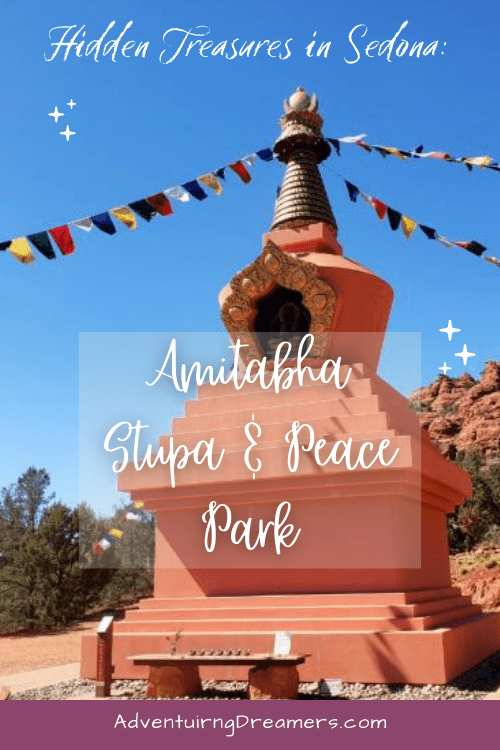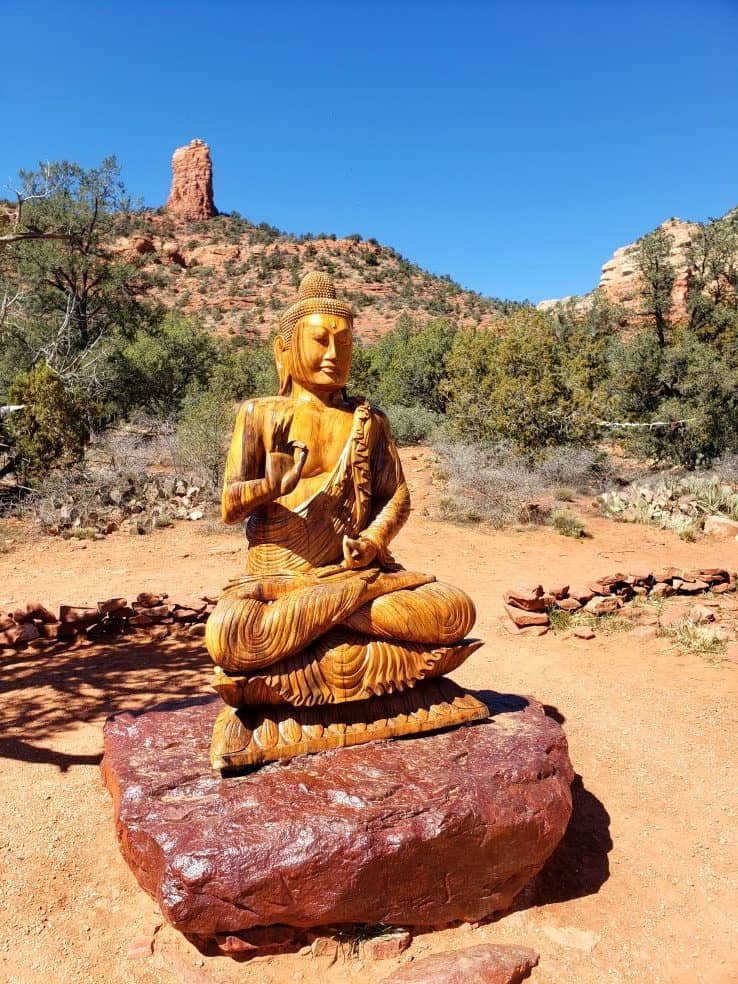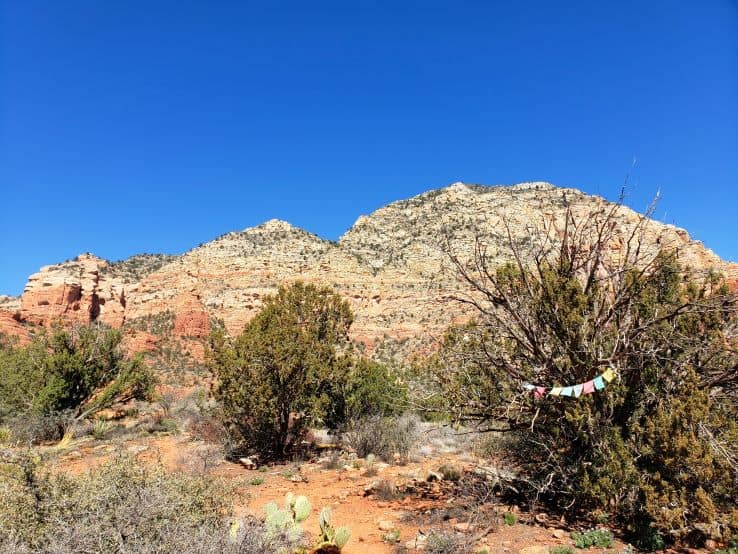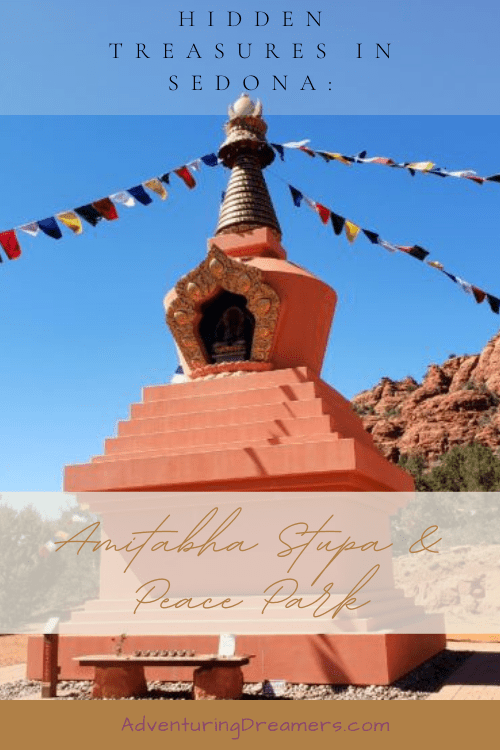Amitabha Stupa and Peace Park: Hidden Treasures in Sedona
Discover This Hidden Treasure in Sedona: Amitabha Stupa and Peace Park
When a friend introduced me to Amitabha Stupa and Peace Park in Sedona, Arizona, I knew I had found one of my new favorite places.


I’d lived in Arizona for seven years before I stumbled upon the gem that is Amitabha Stupa and Peace Park in Sedona.
When I was growing up, my mom lived in Utah and my dad lived in Arizona, so there were a lot of road trips between the two states throughout the years. Often, we’d take a break from the drive and visit the little town of Sedona deep in the middle of Red Rock Country.
I grew up loving the atmosphere of Sedona. It’s a spiritual vortex and there is no denying that the town has got a certain vibe to it. So, after I moved to Arizona in 2013, I made it a point to make my way up to Sedona every month or so to enjoy the hiking, shopping, and general energy of this special town.
When a friend recommended I should visit Amitabha Stupa and Peace Park, they were surprised to find out I’d never heard of it. I’m a sort of spiritual junkie and this place is a hive for the avid spiritualist. The park is a magnet for people of any belief system to come and practice quiet meditation or enjoy a peaceful hike in nature.
It’s no surprise that I completely fell in love with the Amitabha Stupa and Peace Park and totally recommend it to anyone visiting Sedona, whether you’re a spiritual enthusiast like me, or simply looking for the best-hidden gems in town.

Amitabha Stupa and Peace Park History
The Amitabha Stupa and Peace Park is a 14-acre park at the base of Thunder Mountain. It was the vision of Buddhist leader Jetsunma Ahkon Lhamo who visited Sedona in 1997. It took seven years, but in 2004, the park opened and Jesunma’s vision became reality. They named the consecrated stupa after the Buddhist deity Amitabha, the Buddha of limitless light and enlightenment.
What is Amitabha Stupa?

A stupa is a Buddhist monument filled with prayers, holy texts, and other sacred objects. They’re thought to be beacons of compassion and bless those who visit them. They are the embodiment of all Buddha’s wisdom and compassion.
The purpose of a stupa is to raise well-being and happiness for this planet. A stupa protects one from elements that cause harm like illness and war and promote harmony in the world.
The Amitabha Stupa is 36 feet tall and represents spiritual transformation. You don’t have to be a Buddhist to benefit from the power of a stupa and the Peace Park is welcoming to all no matter what your spiritual beliefs or background might be.
What to do while visiting the Amitabha Stupa
The stupa lies in the center of a 14-acre park. There are hiking trails, a river bed, and plenty of little nooks and crannies to hide away in to process deep thought. Whether you’re visiting the park for a spiritual reason, want to connect with nature, or are curious to learn about the park’s history, there is plenty to do and explore.
The park is at the base of Thunder Mountain and there are several trailheads that sprout off from the park if you feel like hiking. You can meditate on a meditation platform set up across from the stupa. There are also several benches hidden throughout the park for more private practice. The last time I went, I walked down to the river bed and found the perfect meditation spot on a rock hidden out of sight from the path. And, of course, there is the stupa as well as a medicine wheel, which is available for anyone who visits the park to use.

How to use the Stupa
Walk around the stupa three times in a clockwise direction while reciting a mantra or prayer. You can pray about anything, though the stupa is a beacon for compassion and the park recommends you pray for the benefit of a loved one, the state of the world, or all sentient beings.
If you don’t have a prayer or a mantra in mind, you can borrow the Buddhist mantra of infinite compassion:
OM MANI PEDME HUNG.
When translated, this means, “The jewel is in the lotus.”
Each word in the mantra has a deeper meaning when used in meditation or prayer.
Om is the primordial sound of all creation. Ma represents dissolving jealousy and attachment to fleeting pleasures. Pedme dissolves attachment to prejudices. Hung dissolves anger, hatred, and aggression.
Once you have finished walking around the stupa, seal your prayer or mantra with a final thought. The stupa recommends using, “By this effort, may all sentient beings be free of suffering. May their minds be filled with the nectar of virtue. In this way, may all causes resulting in suffering be extinguished, and only the light of compassion shine throughout all realms.”
How to use the medicine wheel
The medicine wheel is an ancient Native American symbol that represents the circle of life. When you need guidance, healing, or clarity, walk the wheel to help you find it.
To use the medicine wheel, you enter through the East with your intention in mind and then walk clockwise around the circle.
Each section of the wheel represents a part of life. The East represents springtime, rebirth, and the awakening of consciousness. The South is summer, growth, and compassion. The West is fall. It represents looking inward. Finally, the North is winter and it embodies wisdom and cleansing of the past.

How to get to the Amitabha Stupa and Peace Park
The Stupa is located at:
2650 Pueblo Dr, Sedona, AZ 86336
The Amitabha Stupa and Peace Park is at the base of Thunder Mountain not too far from the Main Street District.
From Uptown Sedona at the intersection of 89A and 179, you’ll go East on 89A to Andante Drive, which is across the street from The Golden Goose American Grill. You’ll turn North (right) and drive up the road through a residential area. You’ll turn East (left) on Pueblo Drive. Then you’ll take an immediate right onto a dirt road and follow signs for the stupa.
Parking and entrance to the park are free. The park is open from 7 am to 5 pm Monday—Sunday.
Once you’re parked, it’s just a short trek up a hill to get you to the stupa. Unfortunately, the trail is not wheelchair friendly, but you can call 1-877-788-7229 a couple of days in advance of your trip and request a service road be opened that grants direct access to the stupa.

Hiking near the Amitabha Stupa and Peace Park
Each of these hikes is dog-friendly as long as your furry friend is on a leash. They’re pretty popular, so expect to see other people on the trails as well as mountain bikers. The best time to hike in Sedona is in the spring and fall.
Enjoy gorgeous views of red rocks and desert scenery when hiking along any of these trails.
Andante Trail Head
Andante is an easy and quick hike near the stupa. Hike Andante as a point-to-point trail that’s just over half a mile long, or use it to connect with Thunder Mountain trail to create a 3-mile loop. When combined with Thunder Mountain Trail the hike goes from fairly easy to moderately challenging.
Thunder Mountain
This point-to-point trail is moderately challenging and is 1.4-miles long. Use it to connect with Andante Trail which creates a 3-mile loop around the area.
Chimney Rock Pass
This loop trail is moderately challenging and is 1.7-miles long.
Little Sugar Loaf
This easy loop trail is 1.9-miles long.
Looking for more things to do in Sedona? Check out this list of activities.
Staying in Sedona overnight? Use Booking.com to find a room that fits your needs.
Did you enjoy this hiking guide? Check out some of our others here:
- 15 of the Best Peak Hikes Near Tucson, Arizona
- 9 Hidden Little Known Hikes in Phoenix
- Exploring Mount Beacon: The Ultimate Guide to Casino Trail

Booking a trip to Arizona?
Here are a few helpful services:
Booking.com | Find a comfy place to lay your head after a full day of adventuring.
Vrbo | If you’re looking for a more homey vibe, these rental homes might do the trick.
Expedia | Whether you’re looking for some wheels or a flight, you can find a way to get to your destination here.
Get Your Guide | Find local attractions and tours and book tickets to your excursions.
TSA | If you’re flying, check out the TSA page to make sure that you pack to TSA regulations.
Arizona Travel Guides:
Staying in Sedona? You might want to check out my Day Trip to Sedona Guide to help jumpstart your itinerary.
If you’re visiting Phoenix, here’s my 5-Day Phoenix Travel Guide to help you plan your stay.
Only staying in Pheonix for a day? Check out my 24-hours in Phoenix Itinerary.
Need help figuring out what to pack? Here is my Arizona Packing List Essentials for Every Time Of Year Packing Guide.
If you’re staying in Phoenix but want to spend a little time in the desert, these 9 Little-Known Hikes in Phoenix will help you get that nature connection.
Click Here to see more from the Adventuring Dreamers Resources.





